A Report on HRM Theories, Culture, and Management Styles at M&S
VerifiedAdded on 2023/01/07
|7
|1509
|39
Report
AI Summary
This report provides an overview of Human Resource Management (HRM) theories and practices at Marks & Spencer (M&S), a British multinational retailer. It covers key HRM theories such as Maslow's hierarchy of needs, explaining how M&S applies these theories to enhance employee motivation and performance through fulfilling physiological, safety, belongingness, esteem, and self-actualization needs. The report also discusses the role of HRM in training and development, recruitment, and appraisals, highlighting the use of Adam's equity theory. Furthermore, it examines the democratic and transformational management styles employed by M&S, along with the application of task culture within the organization. The analysis concludes that HRM plays a vital role in achieving growth and success at Marks & Spencer by effectively managing its workforce and aligning HR practices with organizational goals. Desklib offers this and other solved assignments to aid students in their studies.

Project
Paraphrase This Document
Need a fresh take? Get an instant paraphrase of this document with our AI Paraphraser
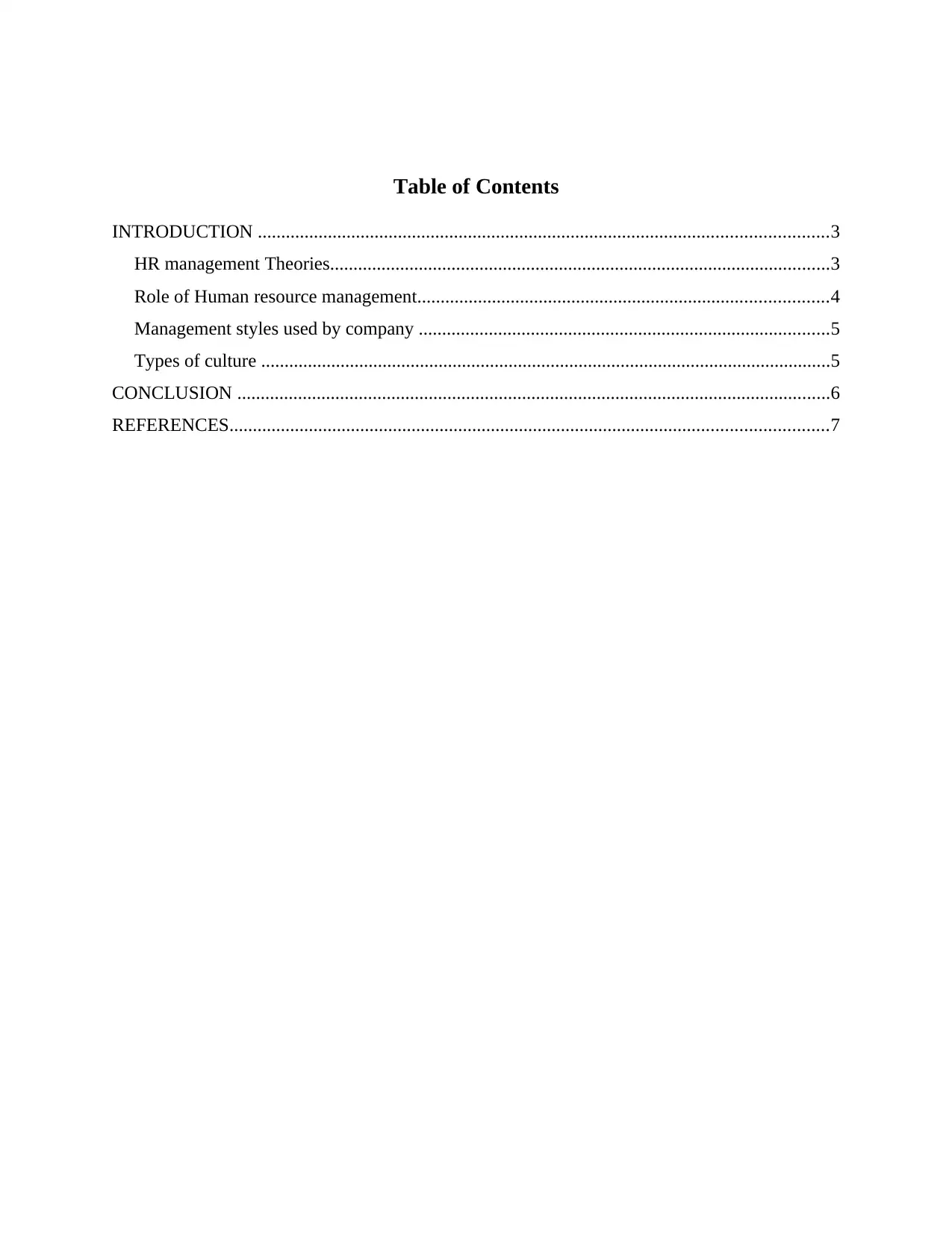
Table of Contents
INTRODUCTION ..........................................................................................................................3
HR management Theories...........................................................................................................3
Role of Human resource management........................................................................................4
Management styles used by company ........................................................................................5
Types of culture ..........................................................................................................................5
CONCLUSION ...............................................................................................................................6
REFERENCES................................................................................................................................7
INTRODUCTION ..........................................................................................................................3
HR management Theories...........................................................................................................3
Role of Human resource management........................................................................................4
Management styles used by company ........................................................................................5
Types of culture ..........................................................................................................................5
CONCLUSION ...............................................................................................................................6
REFERENCES................................................................................................................................7
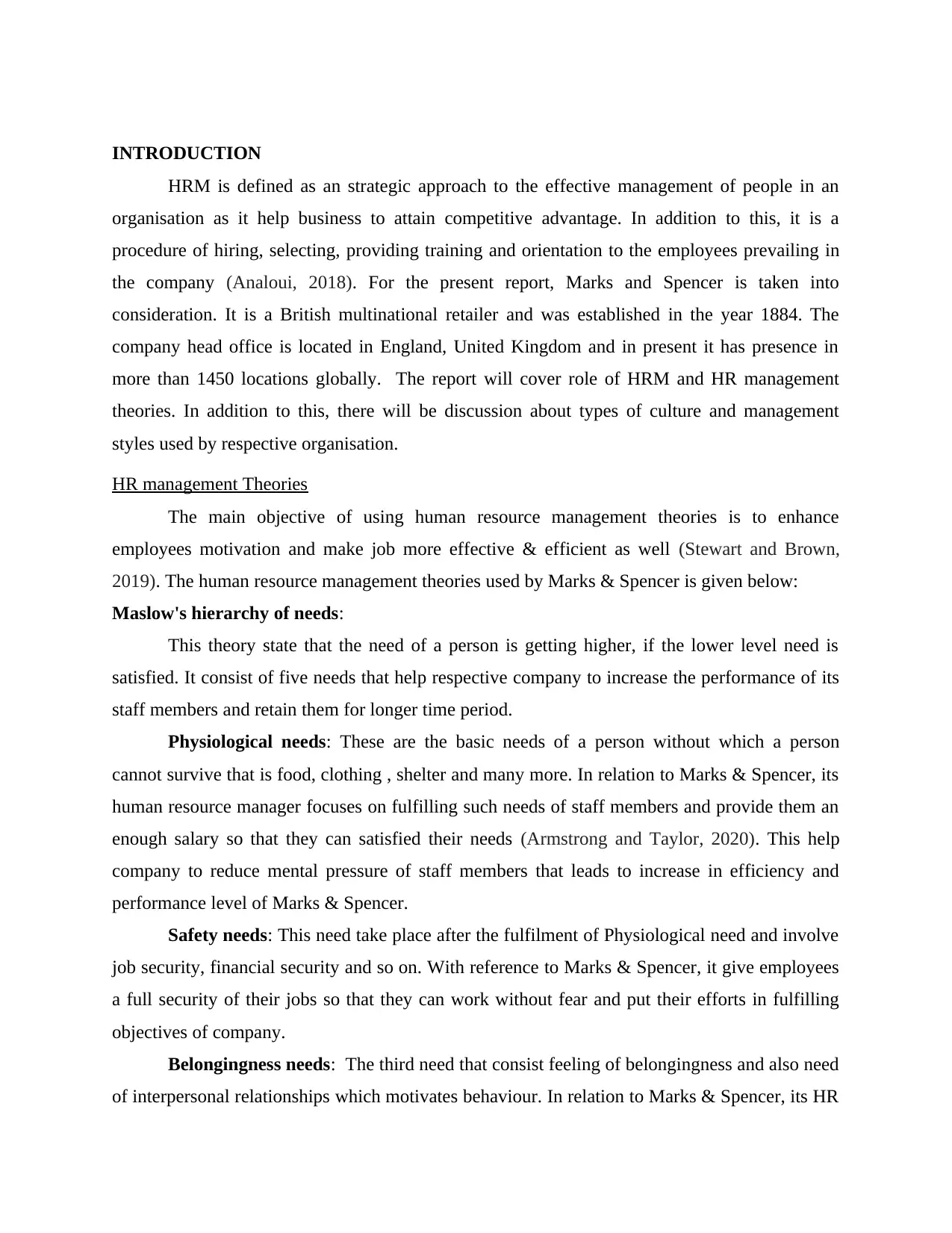
INTRODUCTION
HRM is defined as an strategic approach to the effective management of people in an
organisation as it help business to attain competitive advantage. In addition to this, it is a
procedure of hiring, selecting, providing training and orientation to the employees prevailing in
the company (Analoui, 2018). For the present report, Marks and Spencer is taken into
consideration. It is a British multinational retailer and was established in the year 1884. The
company head office is located in England, United Kingdom and in present it has presence in
more than 1450 locations globally. The report will cover role of HRM and HR management
theories. In addition to this, there will be discussion about types of culture and management
styles used by respective organisation.
HR management Theories
The main objective of using human resource management theories is to enhance
employees motivation and make job more effective & efficient as well (Stewart and Brown,
2019). The human resource management theories used by Marks & Spencer is given below:
Maslow's hierarchy of needs:
This theory state that the need of a person is getting higher, if the lower level need is
satisfied. It consist of five needs that help respective company to increase the performance of its
staff members and retain them for longer time period.
Physiological needs: These are the basic needs of a person without which a person
cannot survive that is food, clothing , shelter and many more. In relation to Marks & Spencer, its
human resource manager focuses on fulfilling such needs of staff members and provide them an
enough salary so that they can satisfied their needs (Armstrong and Taylor, 2020). This help
company to reduce mental pressure of staff members that leads to increase in efficiency and
performance level of Marks & Spencer.
Safety needs: This need take place after the fulfilment of Physiological need and involve
job security, financial security and so on. With reference to Marks & Spencer, it give employees
a full security of their jobs so that they can work without fear and put their efforts in fulfilling
objectives of company.
Belongingness needs: The third need that consist feeling of belongingness and also need
of interpersonal relationships which motivates behaviour. In relation to Marks & Spencer, its HR
HRM is defined as an strategic approach to the effective management of people in an
organisation as it help business to attain competitive advantage. In addition to this, it is a
procedure of hiring, selecting, providing training and orientation to the employees prevailing in
the company (Analoui, 2018). For the present report, Marks and Spencer is taken into
consideration. It is a British multinational retailer and was established in the year 1884. The
company head office is located in England, United Kingdom and in present it has presence in
more than 1450 locations globally. The report will cover role of HRM and HR management
theories. In addition to this, there will be discussion about types of culture and management
styles used by respective organisation.
HR management Theories
The main objective of using human resource management theories is to enhance
employees motivation and make job more effective & efficient as well (Stewart and Brown,
2019). The human resource management theories used by Marks & Spencer is given below:
Maslow's hierarchy of needs:
This theory state that the need of a person is getting higher, if the lower level need is
satisfied. It consist of five needs that help respective company to increase the performance of its
staff members and retain them for longer time period.
Physiological needs: These are the basic needs of a person without which a person
cannot survive that is food, clothing , shelter and many more. In relation to Marks & Spencer, its
human resource manager focuses on fulfilling such needs of staff members and provide them an
enough salary so that they can satisfied their needs (Armstrong and Taylor, 2020). This help
company to reduce mental pressure of staff members that leads to increase in efficiency and
performance level of Marks & Spencer.
Safety needs: This need take place after the fulfilment of Physiological need and involve
job security, financial security and so on. With reference to Marks & Spencer, it give employees
a full security of their jobs so that they can work without fear and put their efforts in fulfilling
objectives of company.
Belongingness needs: The third need that consist feeling of belongingness and also need
of interpersonal relationships which motivates behaviour. In relation to Marks & Spencer, its HR
⊘ This is a preview!⊘
Do you want full access?
Subscribe today to unlock all pages.

Trusted by 1+ million students worldwide
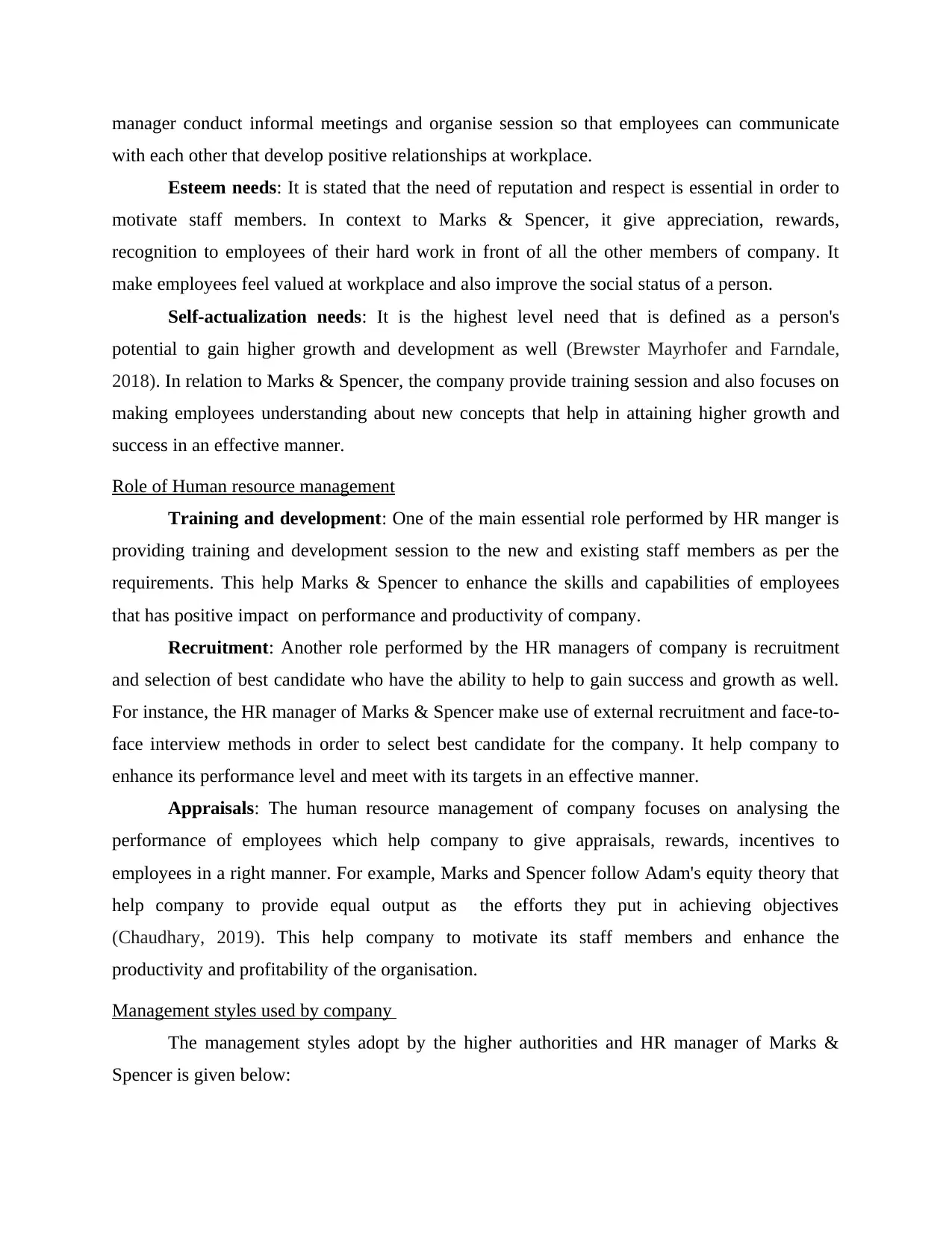
manager conduct informal meetings and organise session so that employees can communicate
with each other that develop positive relationships at workplace.
Esteem needs: It is stated that the need of reputation and respect is essential in order to
motivate staff members. In context to Marks & Spencer, it give appreciation, rewards,
recognition to employees of their hard work in front of all the other members of company. It
make employees feel valued at workplace and also improve the social status of a person.
Self-actualization needs: It is the highest level need that is defined as a person's
potential to gain higher growth and development as well (Brewster Mayrhofer and Farndale,
2018). In relation to Marks & Spencer, the company provide training session and also focuses on
making employees understanding about new concepts that help in attaining higher growth and
success in an effective manner.
Role of Human resource management
Training and development: One of the main essential role performed by HR manger is
providing training and development session to the new and existing staff members as per the
requirements. This help Marks & Spencer to enhance the skills and capabilities of employees
that has positive impact on performance and productivity of company.
Recruitment: Another role performed by the HR managers of company is recruitment
and selection of best candidate who have the ability to help to gain success and growth as well.
For instance, the HR manager of Marks & Spencer make use of external recruitment and face-to-
face interview methods in order to select best candidate for the company. It help company to
enhance its performance level and meet with its targets in an effective manner.
Appraisals: The human resource management of company focuses on analysing the
performance of employees which help company to give appraisals, rewards, incentives to
employees in a right manner. For example, Marks and Spencer follow Adam's equity theory that
help company to provide equal output as the efforts they put in achieving objectives
(Chaudhary, 2019). This help company to motivate its staff members and enhance the
productivity and profitability of the organisation.
Management styles used by company
The management styles adopt by the higher authorities and HR manager of Marks &
Spencer is given below:
with each other that develop positive relationships at workplace.
Esteem needs: It is stated that the need of reputation and respect is essential in order to
motivate staff members. In context to Marks & Spencer, it give appreciation, rewards,
recognition to employees of their hard work in front of all the other members of company. It
make employees feel valued at workplace and also improve the social status of a person.
Self-actualization needs: It is the highest level need that is defined as a person's
potential to gain higher growth and development as well (Brewster Mayrhofer and Farndale,
2018). In relation to Marks & Spencer, the company provide training session and also focuses on
making employees understanding about new concepts that help in attaining higher growth and
success in an effective manner.
Role of Human resource management
Training and development: One of the main essential role performed by HR manger is
providing training and development session to the new and existing staff members as per the
requirements. This help Marks & Spencer to enhance the skills and capabilities of employees
that has positive impact on performance and productivity of company.
Recruitment: Another role performed by the HR managers of company is recruitment
and selection of best candidate who have the ability to help to gain success and growth as well.
For instance, the HR manager of Marks & Spencer make use of external recruitment and face-to-
face interview methods in order to select best candidate for the company. It help company to
enhance its performance level and meet with its targets in an effective manner.
Appraisals: The human resource management of company focuses on analysing the
performance of employees which help company to give appraisals, rewards, incentives to
employees in a right manner. For example, Marks and Spencer follow Adam's equity theory that
help company to provide equal output as the efforts they put in achieving objectives
(Chaudhary, 2019). This help company to motivate its staff members and enhance the
productivity and profitability of the organisation.
Management styles used by company
The management styles adopt by the higher authorities and HR manager of Marks &
Spencer is given below:
Paraphrase This Document
Need a fresh take? Get an instant paraphrase of this document with our AI Paraphraser
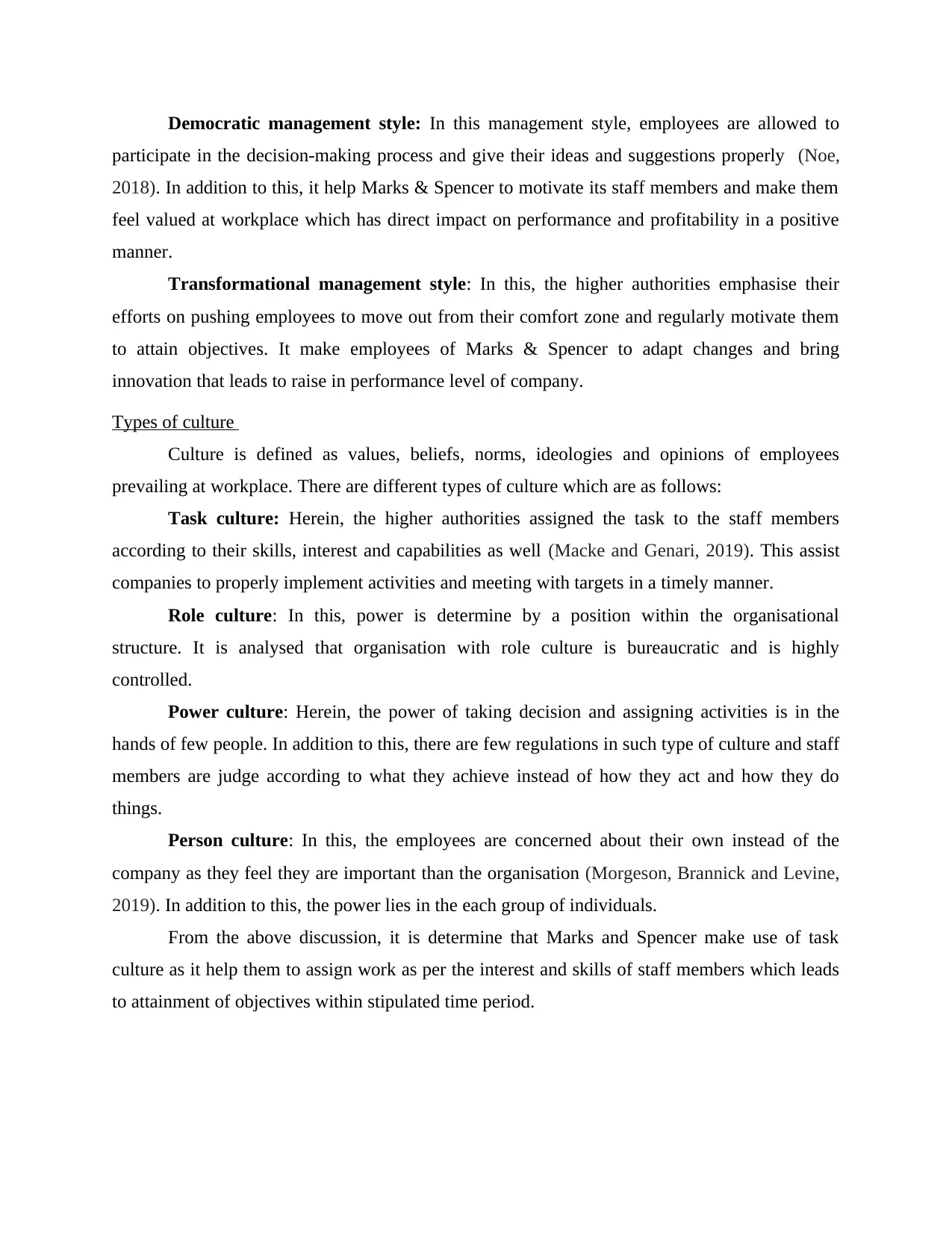
Democratic management style: In this management style, employees are allowed to
participate in the decision-making process and give their ideas and suggestions properly (Noe,
2018). In addition to this, it help Marks & Spencer to motivate its staff members and make them
feel valued at workplace which has direct impact on performance and profitability in a positive
manner.
Transformational management style: In this, the higher authorities emphasise their
efforts on pushing employees to move out from their comfort zone and regularly motivate them
to attain objectives. It make employees of Marks & Spencer to adapt changes and bring
innovation that leads to raise in performance level of company.
Types of culture
Culture is defined as values, beliefs, norms, ideologies and opinions of employees
prevailing at workplace. There are different types of culture which are as follows:
Task culture: Herein, the higher authorities assigned the task to the staff members
according to their skills, interest and capabilities as well (Macke and Genari, 2019). This assist
companies to properly implement activities and meeting with targets in a timely manner.
Role culture: In this, power is determine by a position within the organisational
structure. It is analysed that organisation with role culture is bureaucratic and is highly
controlled.
Power culture: Herein, the power of taking decision and assigning activities is in the
hands of few people. In addition to this, there are few regulations in such type of culture and staff
members are judge according to what they achieve instead of how they act and how they do
things.
Person culture: In this, the employees are concerned about their own instead of the
company as they feel they are important than the organisation (Morgeson, Brannick and Levine,
2019). In addition to this, the power lies in the each group of individuals.
From the above discussion, it is determine that Marks and Spencer make use of task
culture as it help them to assign work as per the interest and skills of staff members which leads
to attainment of objectives within stipulated time period.
participate in the decision-making process and give their ideas and suggestions properly (Noe,
2018). In addition to this, it help Marks & Spencer to motivate its staff members and make them
feel valued at workplace which has direct impact on performance and profitability in a positive
manner.
Transformational management style: In this, the higher authorities emphasise their
efforts on pushing employees to move out from their comfort zone and regularly motivate them
to attain objectives. It make employees of Marks & Spencer to adapt changes and bring
innovation that leads to raise in performance level of company.
Types of culture
Culture is defined as values, beliefs, norms, ideologies and opinions of employees
prevailing at workplace. There are different types of culture which are as follows:
Task culture: Herein, the higher authorities assigned the task to the staff members
according to their skills, interest and capabilities as well (Macke and Genari, 2019). This assist
companies to properly implement activities and meeting with targets in a timely manner.
Role culture: In this, power is determine by a position within the organisational
structure. It is analysed that organisation with role culture is bureaucratic and is highly
controlled.
Power culture: Herein, the power of taking decision and assigning activities is in the
hands of few people. In addition to this, there are few regulations in such type of culture and staff
members are judge according to what they achieve instead of how they act and how they do
things.
Person culture: In this, the employees are concerned about their own instead of the
company as they feel they are important than the organisation (Morgeson, Brannick and Levine,
2019). In addition to this, the power lies in the each group of individuals.
From the above discussion, it is determine that Marks and Spencer make use of task
culture as it help them to assign work as per the interest and skills of staff members which leads
to attainment of objectives within stipulated time period.
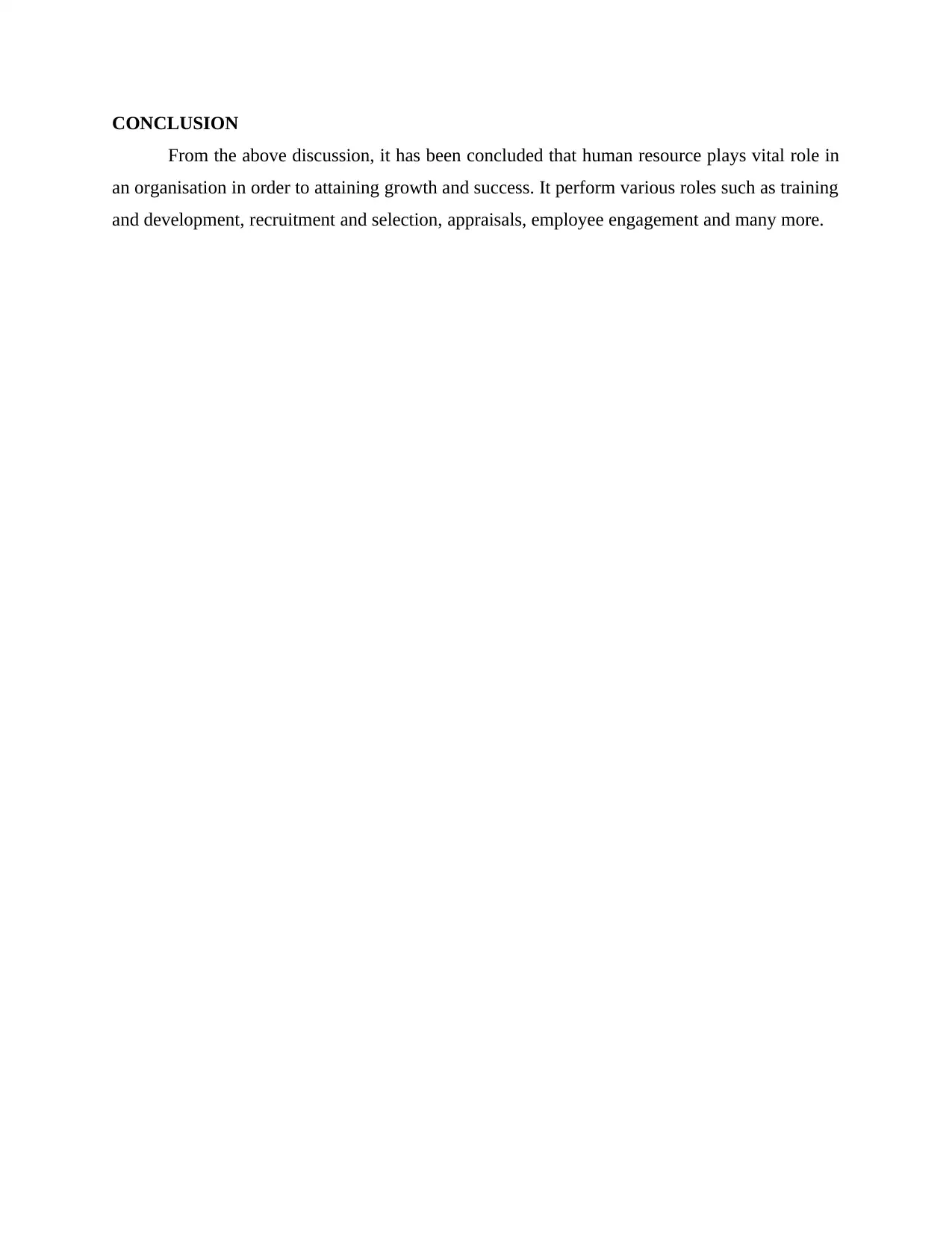
CONCLUSION
From the above discussion, it has been concluded that human resource plays vital role in
an organisation in order to attaining growth and success. It perform various roles such as training
and development, recruitment and selection, appraisals, employee engagement and many more.
From the above discussion, it has been concluded that human resource plays vital role in
an organisation in order to attaining growth and success. It perform various roles such as training
and development, recruitment and selection, appraisals, employee engagement and many more.
⊘ This is a preview!⊘
Do you want full access?
Subscribe today to unlock all pages.

Trusted by 1+ million students worldwide
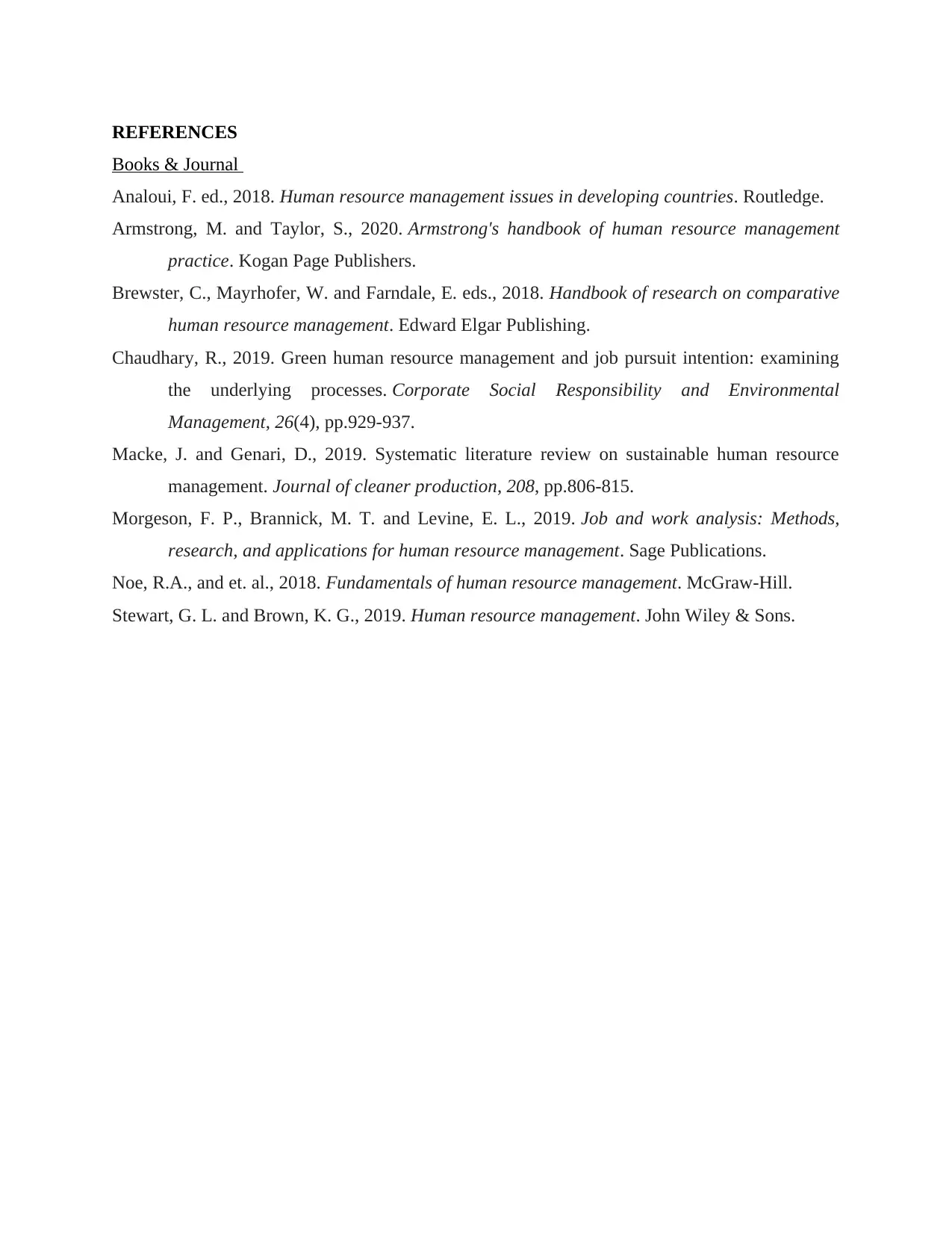
REFERENCES
Books & Journal
Analoui, F. ed., 2018. Human resource management issues in developing countries. Routledge.
Armstrong, M. and Taylor, S., 2020. Armstrong's handbook of human resource management
practice. Kogan Page Publishers.
Brewster, C., Mayrhofer, W. and Farndale, E. eds., 2018. Handbook of research on comparative
human resource management. Edward Elgar Publishing.
Chaudhary, R., 2019. Green human resource management and job pursuit intention: examining
the underlying processes. Corporate Social Responsibility and Environmental
Management, 26(4), pp.929-937.
Macke, J. and Genari, D., 2019. Systematic literature review on sustainable human resource
management. Journal of cleaner production, 208, pp.806-815.
Morgeson, F. P., Brannick, M. T. and Levine, E. L., 2019. Job and work analysis: Methods,
research, and applications for human resource management. Sage Publications.
Noe, R.A., and et. al., 2018. Fundamentals of human resource management. McGraw-Hill.
Stewart, G. L. and Brown, K. G., 2019. Human resource management. John Wiley & Sons.
Books & Journal
Analoui, F. ed., 2018. Human resource management issues in developing countries. Routledge.
Armstrong, M. and Taylor, S., 2020. Armstrong's handbook of human resource management
practice. Kogan Page Publishers.
Brewster, C., Mayrhofer, W. and Farndale, E. eds., 2018. Handbook of research on comparative
human resource management. Edward Elgar Publishing.
Chaudhary, R., 2019. Green human resource management and job pursuit intention: examining
the underlying processes. Corporate Social Responsibility and Environmental
Management, 26(4), pp.929-937.
Macke, J. and Genari, D., 2019. Systematic literature review on sustainable human resource
management. Journal of cleaner production, 208, pp.806-815.
Morgeson, F. P., Brannick, M. T. and Levine, E. L., 2019. Job and work analysis: Methods,
research, and applications for human resource management. Sage Publications.
Noe, R.A., and et. al., 2018. Fundamentals of human resource management. McGraw-Hill.
Stewart, G. L. and Brown, K. G., 2019. Human resource management. John Wiley & Sons.
1 out of 7
Related Documents
Your All-in-One AI-Powered Toolkit for Academic Success.
+13062052269
info@desklib.com
Available 24*7 on WhatsApp / Email
![[object Object]](/_next/static/media/star-bottom.7253800d.svg)
Unlock your academic potential
Copyright © 2020–2025 A2Z Services. All Rights Reserved. Developed and managed by ZUCOL.





